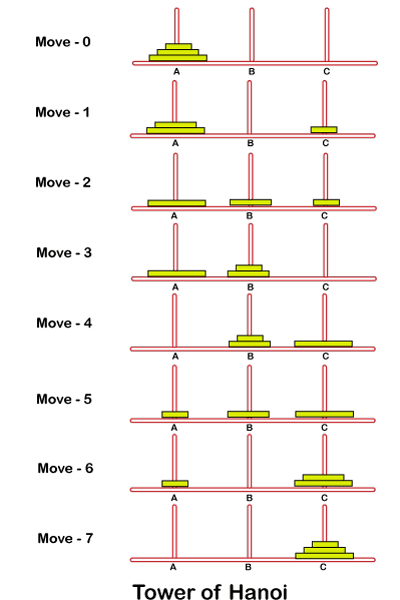使用Python解决汉诺塔问题
在这个教程中,我们将使用Python编写程序来实现著名的 汉诺塔 游戏。我们将使用递归函数来解决这个问题。
什么是汉诺塔游戏
1883年, 法国数学家 埃德华·卢卡斯 发明了汉诺塔数学游戏。启发来自一个传说,据说在古印度寺庙中,年轻的牧师将会面临这个谜题。这个谜题是,有三根柱子和64个圆盘,每个圆盘比另一个圆盘小。要解决这个问题,需要将全部64个圆盘从其中一根柱子移动到另一根柱子,不能违反基本的限制条件。
圆盘只能一次移动一个,且放置在较大的圆盘上面。
另一个民间故事说,当他们解决了这个谜题时,寺庙会化为尘土,世界将会终结。但这需要很长时间,因为根据规则,解决这个问题需要2 64 - 1次移动,即18446744073709551615次/秒,相当于584942417355年。
游戏规则
“汉诺塔” 的规则非常简单,但解决方法稍微复杂。有三个 柱子 。圆盘按照降序堆叠,最大的圆盘堆叠在底部,最小的圆盘堆叠在顶部。
任务是将圆盘从一个源柱移动到另一个目标柱。
不得违反以下规则
- 一次只能移动一个圆盘。
- 从某个柱子的最上面圆盘可以移动。
- 较小的圆盘不能放置在较大的圆盘下面。
移动次数可以计算为 **2 n - 1 ** 。
解决方案
在本教程开始时,我们已经提到将使用递归函数来寻找解决方案。
假设我们在第一根柱子上有三个圆盘; 根据上述公式,我们需要总共7次移动。最左边的柱子称为 源 ,最右边的柱子称为 目标 。中间的柱子称为 辅助 。
辅助柱用于临时存放圆盘。

问题方法
- 创建一个 tower_of_hanoi 的递归函数,并传入两个参数:盘子的数量n和杆子的名称,如 source, aux, 和 target 。
- 我们可以定义当盘子数量为1时的基本情况。在这种情况下,只需将一个盘子从 source 移动到 target 并返回。
- 现在,将剩余的n-1个盘子从 source 移动到 auxiliary ,使用 auxiliary 作为辅助杆。
- 然后,将剩余的1个盘子从 source 移动到 target 。
- 使用 source 作为辅助杆,将剩余的n-1个盘子从辅助杆移动到目标杆。
Python程序/源代码
# Creating a recursive function
def tower_of_hanoi(disks, source, auxiliary, target):
if(disks == 1):
print('Move disk 1 from rod {} to rod {}.'.format(source, target))
return
# function call itself
tower_of_hanoi(disks - 1, source, target, auxiliary)
print('Move disk {} from rod {} to rod {}.'.format(disks, source, target))
tower_of_hanoi(disks - 1, auxiliary, source, target)
disks = int(input('Enter the number of disks: '))
# We are referring source as A, auxiliary as B, and target as C
tower_of_hanoi(disks, 'A', 'B', 'C') # Calling the function
输出:
Enter the number of disks: 3
Move disk 1 from rod A to rod C.
Move disk 2 from rod A to rod B.
Move disk 1 from rod C to rod B.
Move disk 3 from rod A to rod C.
Move disk 1 from rod B to rod A.
Move disk 2 from rod B to rod C.
Move disk 1 from rod A to rod C.
情况 – 2:
Enter number of disks: 2
Move disk 1 from rod A to rod B.
Move disk 2 from rod A to rod C.
Move disk 1 from rod B to rod C.
根据这个公式,移动的次数可以是 2n - 1,所以 n = 3 需要 7 次移动,n = 2 需要 3 次移动。
 极客笔记
极客笔记